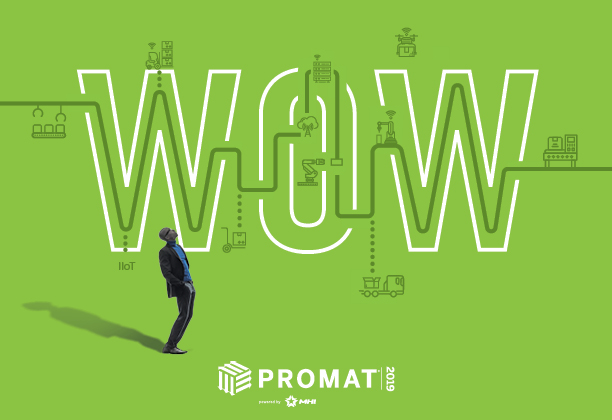My Top Takeaways from ProMat 2019
Managing a supply chain in today's fast-paced, interconnected global economy is extraordinarily complex.
As the agency partner for MHI, the organization that puts on two of North American’s premier supply chain trade shows, the birdsong gregory team recently spent some time in Chicago walking the floor and immersing ourselves in the world of supply chain professionals at ProMat 2019. Before we entered McCormick Place, we knew that managing a supply chain in today’s fast-paced, interconnected global economy was extraordinarily complex, but we had no idea how advanced supply-chain related technology and solutions have become – and how precisely and efficiently products or services can now be moved from supplier to customer.
Full disclosure: I don’t have an advanced degree in systems engineering or supply chain management, so a lot of what I saw at the various booths went way over my head, but here are my a few of my outsider insights from this massive, informational, and entertaining show.
1. Blockchain, blockchain, blockchain.
From keynote addresses to casual conversations, it seems like a lot of people were talking about blockchain technology and the role it can play in an increasingly digitized supply chain. What I learned at ProMat 2019 about blockchain? Think of blockchain as a digital ledger where transactions, contracts, agreements, etc. are held collectively across thousands of computers simultaneously so that everyone on the network can access a secure, scalable, and real-time version of the ledger – which increases both the efficiency and transparency of supply chains and positively impacts everything from warehousing to delivery to payment.
2. People still love schwag.
From squeeze balls to wind up robots to screen cleaners to hats to USB drives to pens to earbuds, the exhibitors at ProMat hand out a LOT of promotional goods – and provide branded tote bags to carry around your schwag collection. At times, I felt like a kid at an Easter egg hunt.
3. In-booth baristas
That’s right. Fancy, gleaming Italian espresso machines (and somebody who knows how to use them) helped brands differentiate on a crowded trade show floor. Face to face engagement is powerful and often the most effective way to cultivate a rapport between a company and potential customers, and the delicious aroma of a freshly pulled espresso drink is sure to draw a crowd and foster 1:1 connections.
4. Supply chains run on data. Supply chain trade shows run on pizza.
I don’t know how much of McCormick Place’s 2.6 MILLION square feet was part of ProMat 2019, but I do know the physical footprint of the show was vast and attendees walked miles everyday – working up an appetite just as big. The two big sellers I noticed out in the food areas were Chicago deep dish pizza – where the lines were DEEP – and the Chicago style hot dog (served with yellow mustard, chopped white onions, sweet relish, and pickled peppers).
5. Take time to recharge at the Hub
My back, my feet, my phone, you get the idea. As the interactive resource center of the show, the Hub was located smack in the center of the venue, and served as a welcome respite from all the action out on the floor. With comfortable seating and recharging stations, you could power back up while learning more about MHI, and the upcoming MODEX 2020 show in Atlanta.
6. People from all over the globe attend ProMat
Given its Midwestern location, I was expecting to meet a lot of folks from Midwestern states (which I did), but our team also talked to attendees from California and Florida, not to mention all the foreign languages we heard on the floor, including Mandarin, Italian, Dutch, German, and French.
7. The Amazon Effect started in Chicago
Long before you could order anything over the internet, you ordered it from either Sears or Montgomery Ward, both leaders of the early mail-order industry who build massive supply chain operations in Chicago to sell directly to consumers across the country by using catalogs and deliveries through the mail. So it’s only fitting that one of North America’s premier manufacturing and supply chain shows takes place every two years in the Windy City – which still serves as one of the nation’s primary hubs for the movement of goods on a local, national, and international scale, with an estimated $1.3 trillion in goods moving into and out of the region each year.


